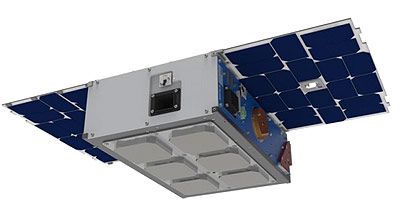CICERO 1, ..., 12 / OSM 1 CICERO (original) (raw)
Please make a donation to support Gunter's Space Page.
Thank you very much for visiting Gunter's Space Page. I hope that this site is useful and informative for you.
If you appreciate the information provided on this site, please consider supporting my work by making a simple and secure donation via PayPal. Please help to run the website and keep everything free of charge. Thank you very much.

CICERO [Tyvak]
CICERO (Community Initiative for Cellular Earth Remote Observation) is a constellation of 24+low-Earth Orbiting (LEO) micro-satellites for performing GPS and Galileo radio occultation (GNSS-RO) of Earth�s atmosphere and surface remote sensing by GNSS reflection. They are operated by GeoOptics.
The system will deliver critical data on the state of the earth to scientists and decision makers worldwide. Products will include high-accuracy profiles of atmospheric pressure, temperature, and moisture; 3D maps of the electron distribution in the ionosphere; and a variety of ocean and ice properties. Principal applications will be weather forecasting, climate research, and space weather monitoring.
Originally GeoOptics developed CICERO 115 kg microsatellites together with the University of Colorado Laboratory for Atmospheric and Space Physics (LASP) using the TriG GNSS-RO payload developed to fly on the FORMOSAT 7 / COSMIC-2 mission. Later during development, the massive miniaturization of the GNSS-RO payload, called Cion, allowed the satellite design to be changed to a much smaller 6U CubeSat based version built by Tyvak Nano-Satellite Systems.
At least one more satellite was built by Orbital Solutions Monaco (OSM) on Tyvak's design and is owned by OSM. This satellite is operated with the GeoOptics satellites for a share on the revenue.
CICERO will be built up over time, starting with the launch of a first pathfinder spacecraft in mid 2017. The first four operational satellites, called OP-1 constellation, will follow soon after.
For later launches, GeoOptics reportedly has an agreement with Virgin Galactic to use the LauncherOne rocket.
CICERO satellites are launched as secondary payloads and on shared launches:
- CICERO 6 was the first satellite launched in June 2017 on a PSLV-XL rocket.
- Three more satellites, CICERO 1, 2 and 3 followed in July 2017 on a Russian Soyuz-2-1a Fregat booster. Reportedly these three satellites are all inoperative after deployment.
- CICERO 7 was successfully launched on a PSLV-XL on 12 January 2018.
- One more satellite, CICERO 10, was launched in November 2018 on an Electron KS rocket.
- CICERO 8 was launched in November 2018 on a PSLV-CA launch vehicle.
- OSM-1 CICERO was launched in September 2020 on a Vega rocket.
| Nation: | USA (CICERO) / Monaco (OSM) |
|---|---|
| Type / Application: | Earth observation |
| Operator: | GeoOptics Inc. / OSM (owner #OSM-1) |
| Contractors: | Tyvak Nano-Satellite Systems, Inc. (#1-12); Orbital Solutions Monaco (#OSM-1) |
| Equipment: | Cion GPS radio occultation payload |
| Configuration: | CubeSat (6U) |
| Propulsion: | |
| Power: | Solar cells, batteries |
| Lifetime: | |
| Mass: | ~ 10 kg |
| Orbit: | 586 km × 602 km, 97.61� (#1, 2, 3); 496 km × 515 km, 97.45� (#6); 493 km × 504 km, 97.56� (#7); 477 km × 499 km, 97.49� (#8); 490 km × 515 km, 85.04� (#10), 534 km � 537 km, 97.52� (#OSM) |
References:
- Tyvak: TYVAK a Terran Orbital Company Signs Contract to Build First Tech Demo CICERO Satellite, 28 April 2015
- Thomas P. Yunck, Conrad C. Lautenbacher, Alex Saltman, Austin Williams, Marco Villa: CICERO: Nanosat arrays for continuous Earth remote observation (Abstract)
- Dave Williamson: Small Satellites: The Execution and Launch of a GPS Radio Occultation Instrument in a 6U Nanosatellite